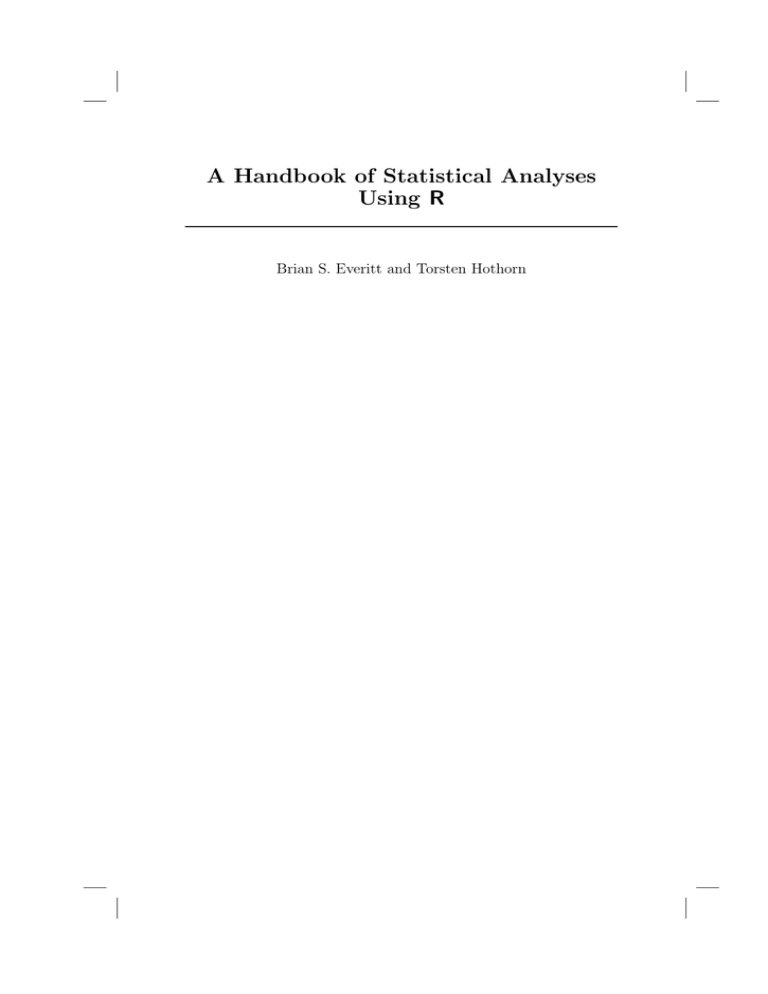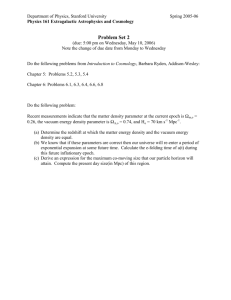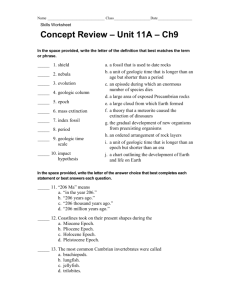Analysis of Variance
advertisement

A Handbook of Statistical Analyses
Using R
Brian S. Everitt and Torsten Hothorn
CHAPTER 4
Analysis of Variance: Weight Gain,
Foster Feeding in Rats, Water
Hardness and Male Egyptian Skulls
4.1 Introduction
4.2 Analysis of Variance
4.3 Analysis Using R
4.3.1 Weight Gain in Rats
Before applying analysis of variance to the data in Table ?? we should try to
summarise the main features of the data by calculating means and standard
deviations and by producing some hopefully informative graphs. The data is
available in the data.frame weightgain. The following R code produces the
required summary statistics
R> data("weightgain", package = "HSAUR")
R> tapply(weightgain$weightgain,
+
list(weightgain$source, weightgain$type), mean)
High Low
Beef
100.0 79.2
Cereal 85.9 83.9
R> tapply(weightgain$weightgain,
+
list(weightgain$source, weightgain$type), sd)
High
Low
Beef
15.13642 13.88684
Cereal 15.02184 15.70881
To apply analysis of variance to the data we can use the aov function in R
and then the summary method to give us the usual analysis of variance table.
The model formula specifies a two-way layout with interaction terms, where
the first factor is source, and the second factor is type.
R> wg_aov <- aov(weightgain ~ source * type, data = weightgain)
The estimates of the intercept and the main and interaction effects can be
extracted from the model fit by
R> coef(wg_aov)
(Intercept)
100.0
sourceCereal:typeLow
18.8
sourceCereal
-14.1
3
typeLow
-20.8
4
R> plot.design(weightgain)
ANALYSIS OF VARIANCE
88
Beef
86
mean of weightgain
90
92
High
82
84
Cereal
Low
source
type
Factors
Figure 4.1
Plot of mean weight gain for each level of the two factors.
Note that the model was fitted with the restrictions γ1 = 0 (corresponding to
Beef) and β1 = 0 (corresponding to High) because treatment contrasts were
used as default as can be seen from
R> options("contrasts")
$contrasts
unordered
"contr.treatment"
ordered
"contr.poly"
Thus, the coefficient for source of −14.1 can be interpreted as an
P estimate of
the difference γ2 − γ1 . Alternatively, we can use the restriction i γi = 0 by
R> coef(aov(weightgain ~ source + type + source:type,
+
data = weightgain, contrasts = list(source = contr.sum)))
(Intercept)
92.95
source1
7.05
typeLow
-11.40
ANALYSIS USING R
5
R> summary(wg_aov)
Df Sum Sq Mean Sq F value Pr(>F)
source
1
221
220.9
0.988 0.3269
type
1
1300 1299.6
5.812 0.0211 *
source:type 1
884
883.6
3.952 0.0545 .
Residuals
36
8049
223.6
--Signif. codes: 0 '***' 0.001 '**' 0.01 '*' 0.05 '.' 0.1 ' ' 1
Figure 4.2
R output of the ANOVA fit for the weightgain data.
source1:typeLow
-9.40
4.3.2 Foster Feeding of Rats of Different Genotype
As in the previous subsection we will begin the analysis of the foster feeding
data in Table ?? with a plot of the mean litter weight for the different genotypes of mother and litter (see Figure 4.4). The data are in the data.frame
foster
R> data("foster", package = "HSAUR")
We can derive the two analyses of variance tables for the foster feeding
example by applying the R code
R> summary(aov(weight ~ litgen * motgen, data = foster))
to give
Df Sum Sq Mean Sq F value
litgen
3
60.2
20.05
0.370
motgen
3 775.1 258.36
4.763
litgen:motgen 9 824.1
91.56
1.688
Residuals
45 2440.8
54.24
--Signif. codes: 0 '***' 0.001 '**' 0.01
Pr(>F)
0.77522
0.00574 **
0.12005
'*' 0.05 '.' 0.1 ' ' 1
and then the code
R> summary(aov(weight ~ motgen * litgen, data = foster))
to give
Df Sum Sq Mean Sq F value
motgen
3 771.6 257.20
4.742
litgen
3
63.6
21.21
0.391
motgen:litgen 9 824.1
91.56
1.688
Residuals
45 2440.8
54.24
--Signif. codes: 0 '***' 0.001 '**' 0.01
Pr(>F)
0.00587 **
0.76000
0.12005
'*' 0.05 '.' 0.1 ' ' 1
There are (small) differences in the sum of squares for the two main effects
and, consequently, in the associated F -tests and p-values. This would not be
true if in the previous example in Subsection 4.3.1 we had used the code
95
weightgain$source
85
90
Beef
Cereal
80
mean of weightgain$weightgain
100
6
ANALYSIS OF VARIANCE
R> interaction.plot(weightgain$type, weightgain$source,
+
weightgain$weightgain)
High
Low
weightgain$type
Figure 4.3
Interaction plot of type × source.
R> summary(aov(weightgain ~ type * source, data = weightgain))
instead of the code which produced Figure 4.2 (readers should confirm that
this is the case).
We can investigate the effect of genotype B on litter weight in more detail
by the use of multiple comparison procedures (see Everitt, 1996). Such procedures allow a comparison of all pairs of levels of a factor whilst maintaining
the nominal significance level at its selected value and producing adjusted
confidence intervals for mean differences. One such procedure is called Tukey
honest significant differences suggested by Tukey (1953), see Hochberg and
Tamhane (1987) also. Here, we are interested in simultaneous confidence intervals for the weight differences between all four genotypes of the mother.
First, an ANOVA model is fitted
ANALYSIS USING R
R> plot.design(foster)
7
A
54
A
B
I
52
JI
50
mean of weight
56
58
B
J
litgen
motgen
Factors
Figure 4.4
Plot of mean litter weight for each level of the two factors for the
foster data.
R> foster_aov <- aov(weight ~ litgen * motgen, data = foster)
which serves as the basis of the multiple comparisons, here with allpair differences by
R> foster_hsd <- TukeyHSD(foster_aov, "motgen")
R> foster_hsd
Tukey multiple comparisons of means
95% family-wise confidence level
Fit: aov(formula = weight ~ litgen * motgen, data = foster)
$motgen
B-A
diff
3.330369
lwr
upr
p adj
-3.859729 10.5204672 0.6078581
8
R> plot(foster_hsd)
ANALYSIS OF VARIANCE
J−I
J−B
I−B
J−A
I−A
B−A
95% family−wise confidence level
−15
−10
−5
0
5
10
Differences in mean levels of motgen
Figure 4.5
I-A
J-A
I-B
J-B
J-I
Graphical presentation of multiple comparison results for the foster
feeding data.
-1.895574
-6.566168
-5.225943
-9.896537
-4.670593
-8.841869 5.0507207 0.8853702
-13.627285 0.4949498 0.0767540
-12.416041 1.9641552 0.2266493
-17.197624 -2.5954489 0.0040509
-11.731711 2.3905240 0.3035490
A convenient plot method exists for this object and we can get a graphical
representation of the multiple confidence intervals as shown in Figure 4.5. It
appears that there is only evidence for a difference in the B and J genotypes.
4.3.3 Water Hardness and Mortality
The water hardness and mortality data for 61 large towns in England and
Wales (see Table 2.3) was analysed in Chapter 2 and here we will extend the
ANALYSIS USING R
9
analysis by an assessment of the differences of both hardness and mortality
in the North or South. The hypothesis that the two-dimensional mean-vector
of water hardness and mortality is the same for cities in the North and the
South can be tested by Hotelling-Lawley test in a multivariate analysis of
variance framework. The R function manova can be used to fit such a model
and the corresponding summary method performs the test specified by the
test argument
R> data("water", package = "HSAUR")
R> summary(manova(cbind(hardness, mortality) ~ location,
+
data = water), test = "Hotelling-Lawley")
Df Hotelling-Lawley approx F num Df den Df
Pr(>F)
location
1
0.90021
26.106
2
58 8.217e-09
Residuals 59
location ***
Residuals
--Signif. codes:
0 '***' 0.001 '**' 0.01 '*' 0.05 '.' 0.1 ' ' 1
The cbind statement in the left hand side of the formula indicates that a
multivariate response variable is to be modelled. The p-value associated with
the Hotelling-Lawley statistic is very small and there is strong evidence that
the mean vectors of the two variables are not the same in the two regions.
Looking at the sample means
R> tapply(water$hardness, water$location, mean)
North
South
30.40000 69.76923
R> tapply(water$mortality, water$location, mean)
North
South
1633.600 1376.808
we see large differences in the two regions both in water hardness and mortality, where low mortality is associated with hard water in the South and high
mortality with soft water in the North (see Figure ?? also).
4.3.4 Male Egyptian Skulls
We can begin by looking at a table of mean values for the four measurements within each of the five epochs. The measurements are available in the
data.frame skulls and we can compute the means over all epochs by
R> data("skulls", package = "HSAUR")
R> means <- aggregate(skulls[,c("mb", "bh", "bl", "nh")],
+
list(epoch = skulls$epoch), mean)
R> means
10
ANALYSIS OF VARIANCE
R> pairs(means[,-1],
+
panel = function(x, y) {
+
text(x, y, abbreviate(levels(skulls$epoch)))
+
})
133.5
cAD1
50.5
cAD1
c200
c200
c185
51.5
cAD1
c200
c185
c185
mb
c330c330
133.5
c400
c400
c185
c185
c400
c400
c185
c400
c330c330
132.0
c330
c400
132
c330
136
132.0
134
130.5
130.5
c200
c200
bh
cAD1
cAD1
cAD1
c330 c400
c400
c330
bl
c185
c200
c185
c200
c200
cAD1
cAD1
51.5
c200
cAD1
c200
cAD1
cAD1
94
c185
96
98
c400c330
c200
c200
cAD1
50.5
nh
c400
c185
c185
c400
c330
132
Figure 4.6
c185
c400
c330
134
136
c330
94
96
98
Scatterplot matrix of epoch means for Egyptian skulls data.
epoch
mb
bh
bl
nh
1 c4000BC 131.3667 133.6000 99.16667 50.53333
2 c3300BC 132.3667 132.7000 99.06667 50.23333
3 c1850BC 134.4667 133.8000 96.03333 50.56667
4 c200BC 135.5000 132.3000 94.53333 51.96667
5 cAD150 136.1667 130.3333 93.50000 51.36667
It may also be useful to look at these means graphically and this could be
done in a variety of ways. Here we construct a scatterplot matrix of the means
using the code attached to Figure 4.6.
ANALYSIS USING R
11
There appear to be quite large differences between the epoch means, at
least on some of the four measurements. We can now test for a difference
more formally by using MANOVA with the following R code to apply each of
the four possible test criteria mentioned earlier;
R> skulls_manova <- manova(cbind(mb, bh, bl, nh) ~ epoch,
+
data = skulls)
R> summary(skulls_manova, test = "Pillai")
Df Pillai approx F num Df den Df
Pr(>F)
epoch
4 0.35331
3.512
16
580 4.675e-06 ***
Residuals 145
--Signif. codes: 0 '***' 0.001 '**' 0.01 '*' 0.05 '.' 0.1 ' ' 1
R> summary(skulls_manova, test = "Wilks")
Df
Wilks approx F num Df den Df
Pr(>F)
epoch
4 0.66359
3.9009
16 434.45 7.01e-07 ***
Residuals 145
--Signif. codes: 0 '***' 0.001 '**' 0.01 '*' 0.05 '.' 0.1 ' ' 1
R> summary(skulls_manova, test = "Hotelling-Lawley")
Df Hotelling-Lawley approx F num Df den Df
epoch
4
0.48182
4.231
16
562
Residuals 145
Pr(>F)
epoch
8.278e-08 ***
Residuals
--Signif. codes: 0 '***' 0.001 '**' 0.01 '*' 0.05 '.' 0.1 ' ' 1
R> summary(skulls_manova, test = "Roy")
Df
Roy approx F num Df den Df
Pr(>F)
epoch
4 0.4251
15.41
4
145 1.588e-10 ***
Residuals 145
--Signif. codes: 0 '***' 0.001 '**' 0.01 '*' 0.05 '.' 0.1 ' ' 1
The p-value associated with each four test criteria is very small and there is
strong evidence that the skull measurements differ between the five epochs. We
might now move on to investigate which epochs differ and on which variables.
We can look at the univariate F -tests for each of the four variables by using
the code
R> summary.aov(skulls_manova)
Response mb :
Df Sum Sq Mean Sq F value
Pr(>F)
epoch
4 502.83 125.707 5.9546 0.0001826 ***
Residuals
145 3061.07 21.111
---
12
Signif. codes:
ANALYSIS OF VARIANCE
0 '***' 0.001 '**' 0.01 '*' 0.05 '.' 0.1 ' ' 1
Response bh :
Df Sum Sq Mean Sq F value Pr(>F)
epoch
4 229.9 57.477 2.4474 0.04897 *
Residuals
145 3405.3 23.485
--Signif. codes: 0 '***' 0.001 '**' 0.01 '*' 0.05 '.' 0.1 ' ' 1
Response bl :
Df Sum Sq Mean Sq F value
Pr(>F)
epoch
4 803.3 200.823 8.3057 4.636e-06 ***
Residuals
145 3506.0 24.179
--Signif. codes: 0 '***' 0.001 '**' 0.01 '*' 0.05 '.' 0.1 ' ' 1
Response nh :
Df Sum Sq Mean Sq F value Pr(>F)
epoch
4
61.2 15.300
1.507 0.2032
Residuals
145 1472.1 10.153
We see that the results for the maximum breadths (mb) and basialiveolar length
(bl) are highly significant, with those for the other two variables, in particular
for nasal heights (nh), suggesting little evidence of a difference. To look at the
pairwise multivariate tests (any of the four test criteria are equivalent in the
case of a one-way layout with two levels only) we can use the summary method
and manova function as follows:
R> summary(manova(cbind(mb, bh, bl, nh) ~ epoch, data = skulls,
+
subset = epoch %in% c("c4000BC", "c3300BC")))
Df
Pillai approx F num Df den Df Pr(>F)
epoch
1 0.027674 0.39135
4
55 0.8139
Residuals 58
R> summary(manova(cbind(mb, bh, bl, nh) ~ epoch, data = skulls,
+
subset = epoch %in% c("c4000BC", "c1850BC")))
Df Pillai approx F num Df den Df Pr(>F)
epoch
1 0.18757
3.1744
4
55 0.02035 *
Residuals 58
--Signif. codes: 0 '***' 0.001 '**' 0.01 '*' 0.05 '.' 0.1 ' ' 1
R> summary(manova(cbind(mb, bh, bl, nh) ~ epoch, data = skulls,
+
subset = epoch %in% c("c4000BC", "c200BC")))
Df Pillai approx F num Df den Df
Pr(>F)
epoch
1 0.30297
5.9766
4
55 0.0004564 ***
Residuals 58
--Signif. codes: 0 '***' 0.001 '**' 0.01 '*' 0.05 '.' 0.1 ' ' 1
ANALYSIS USING R
13
R> summary(manova(cbind(mb, bh, bl, nh) ~ epoch, data = skulls,
+
subset = epoch %in% c("c4000BC", "cAD150")))
Df Pillai approx F num Df den Df
Pr(>F)
epoch
1 0.36182
7.7956
4
55 4.736e-05 ***
Residuals 58
--Signif. codes: 0 '***' 0.001 '**' 0.01 '*' 0.05 '.' 0.1 ' ' 1
To keep the overall significance level for the set of all pairwise multivariate
tests under some control (and still maintain a reasonable power), Stevens
(2001) recommends setting the nominal level α = 0.15 and carrying out each
test at the α/m level where m s the number of tests performed. The results
of the four pairwise tests suggest that as the epochs become further separated
in time the four skull measurements become increasingly distinct.
Bibliography
Everitt, B. S. (1996), Making Sense of Statistics in Psychology: A Second-Level
Course, Oxford, UK: Oxford University Press.
Hochberg, Y. and Tamhane, A. C. (1987), Multiple Comparison Procedures,
New York, USA: John Wiley & Sons.
Stevens, J. (2001), Applied Multivariate Statistics for the Social Sciences,
Mahwah, New Jersey, USA: Lawrence Erlbaum, 4th edition.
Tukey, J. W. (1953), “The problem of multiple comparisons (unpublished
manuscript),” in The Collected Works of John W. Tukey VIII. Multiple
Comparisons: 1948-1983 , New York, USA: Chapman & Hall.




